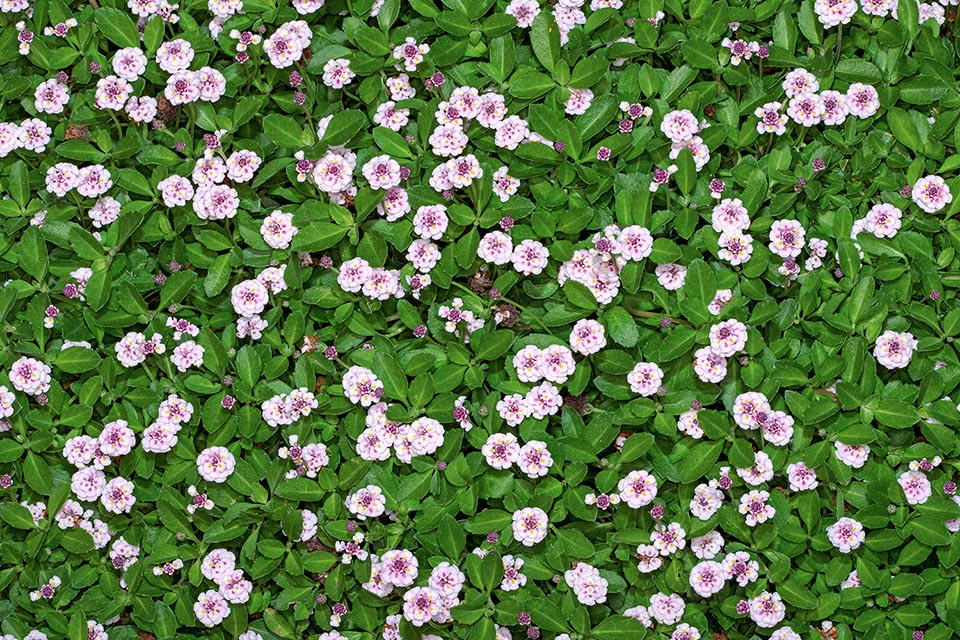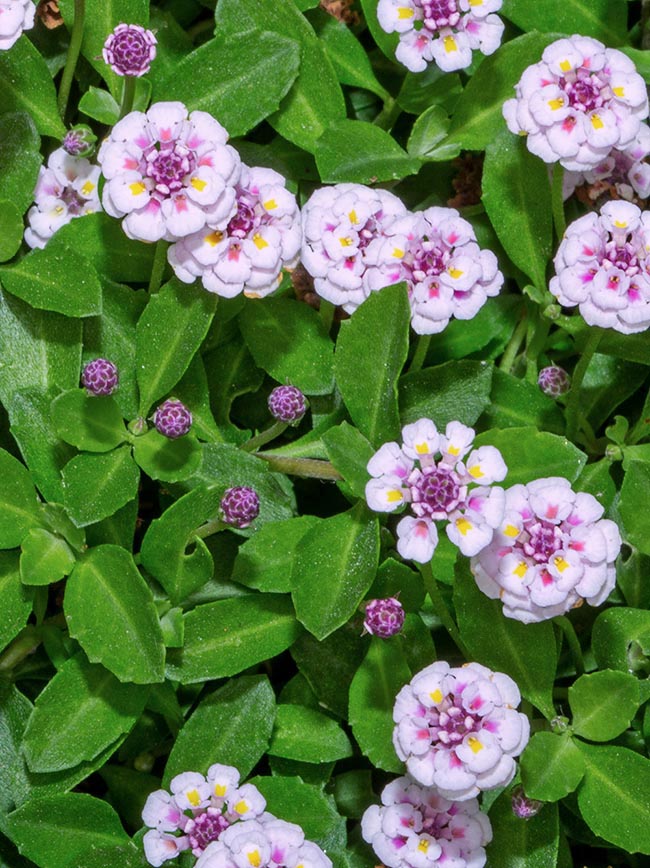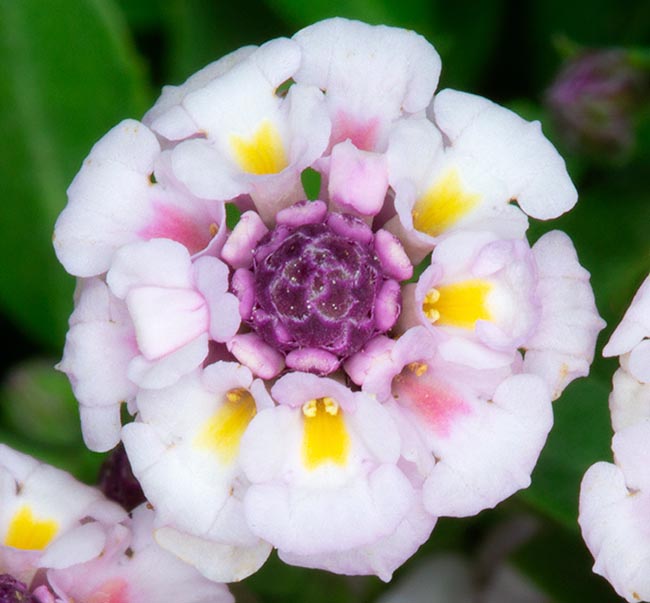Family : Verbenaceae

Text © Prof. Pietro Pavone

English translation by Mario Beltramini

Native to tropical America, Phyla nodiflora perennial herbaceous and forms a thick carpet of prostrate small stems, 30-90 cm long and 6 to 14 cm tall. It grows in full sun or on humid or seasonally flooded soils, along river streams and on the coastal dunes. The roots are woody taproots that may exceed the 60 cm of length © Giuseppe Mazza
Phyla nodiflora (L.) Greene is a species native to the belt included between the northern part of South America and southern USA, with a secondary distribution, favoured by the man, in the tropical and subtropical areas of the Old World, Asia, Africa and Australia.
Common names: Frutto della rana, groviglio di tacchino, fiammifero.
The generic term Phyla comes from the Greek “φῦλον” [phýlon], meaning tribe, because of the aggregated flowers to form almost a tribe, a group. The specific epithet nodiflora comes from the Latin “nōdus”, knot and “flos”, flower, due to the characteristic position and/or disposition of the flower.
Phyla nodiflora grows on humid or seasonally flooded soils, in the alluvial plains, along the banks of the lakes, the rivers, or the coastal dunes. In its origin sites, it is encountered from the sea level up to more than 1000 m of altitude.

Excellent carpet for little frequented lawns, like many Verbenaceae is a species rich of medicinal virtues © G. Mazza
It is a perennial herbaceous plant forming an intricate carpet of prostrate small stems, covered by hairs when young, a little fleshy, 30-90 cm long, and 6 to14 cm tall. The roots are woody taproots, usually 50-60 cm long, even more at times, that may form from the nodes of the stem, axillary at the leaves, forming an extensive root system.
The leaves are small, slightly fleshy, opposite, sessile or on short petiole, 5-40 mm long, 4-20 mm broad, subacute at the apex, with margin jagged in the upper mid, entire in the lowest one.
They can be hoary, that is, having a greyish green look due to a cover of hairs on their surface. In the zones with tropical climates the leaves are persistent.
The flowers are hermaphrodite, zygomorphous, grouped in short spikes, dense or sub-globose or, while blooming, briefly ovoidal. They somewhat recall, on a smaller size, those of the more known Lantana camara.
The calyx is persistent, membranous, deeply divided with 1,5-2 mm long lobes, hyaline or dark violet and slightly toothed.
The corolla is gamopetalous, of mauve pink or white colour, with yellow throat, often white and violet on the same inflorescence (at time, violet in bud, white when open), about 2,5 mm long.
The tube is 2 mm long and at the mouth, wide 1,5 mm with the upper lip bilobed and erect, and the lower lip long the double, trilobed with oblong median lobe.
P. nodiflora blooms from April to late summer and attracts various lepidopters such as Eurema daira, Calephelis virginiensis, Phyciodes phaon, etc., and several hymenopterans such as Apis mellifera, Augochloropsis metallica, Halictus poeyi, Lasioglossum lepidii, etc.
The fruits are schizocarps, 1,5-2 mm long, glabrous, spheroidal, enclosed in the persistent calyx that, when ripe, separate in two indehiscent mericarps, with one seed each. The fruitification occurs, normally, in October.
P. nodiflora is an important medicinal grass, amply utilized in various parts of the world. In the popular medicine, the aerial parts of the plant find employment as painkillers, antibacterial, emmenagogue, parasiticide, refrigerant, in the treatment of wounds, asthma and loss of consciousness. The infusion of leaves and the soft stems is given to the children for indigestions and to the women after the delivery. In Ayurvedic medicine the plant is used as aphrodisiac, diuretic, and for treating heart diseases, ulcers, bronchitis, fevers, colds, pains in the knee joints and lithiasis. The phytochemical analysis has shown the presence of flavonoids, steroids, glycosides, alkaloids, terpenoids, quinols and quinol glycosides, phenylpropanoids, resin, volatile substances, tannins, and phenols. Consequently, are largely confirmed the effects already known to the popular medicine.
From an ornamental point of view P. nodiflora is a plant suitable to form low-passage lawns, in particular in the tropical areas.

The hermaphrodite flowers, grouped in short spikes, last from April to late summer © Giuseppe Mazza
The USA government suggests its employment as a fire break in the areas subject to fires, including the spaces around the buildings as this plant burns with difficulty.
Thanks to the beauty of the colour of its flowers, it is cultivated also in pots. It grows in whatever type of soil, provided well drained, even if humid, but in a sunny position and moderately fertile. In the shade, the plant grows vegetatively but blooms little, tolerating low temperatures up to -7 °C for a short time.
The propagation of the species is done by means of the seeds, to be done in a greenhouse and in spring in individual pots; after two years the small plants are to be interred in late spring or early summer. It can also multiply by means of the rhizomes rooted at the nodes of the leaves.
It is a rustic plant resistant to fungal diseases. Excepting the roots rot that occurs if the soil is not well drained and the water intake is excessive, in this case it fears also the attacks of aphids and scales, insects that colonize the nodes of the stems. In order to keep the lawn always effective and clean, it is good practice to eliminate all infestant herba growing between the plants when the lawn is not yet too thick.
Synonyms: Bertolonia crassifolia Raf.; Blairia nodiflora (L.) Gaertn.; Diototheca repens (Bertol.) Raf.; Lantana larranagae Moldenke; Lantana repens Sessé & Moc.; Lantana sarmentosa Spreng. ex C.B.Clarke; Lippia aegyptiaca Carrière; Lippia fruticosa (Mill.) K.Kenn. ex R.W.Sanders; Lippia incisa (Small) Tidestr.; Lippia incisa (Small) E.D. Schulz; Lippia litoralis Phil.; Lippia nodiflora (L.) Michx.; Lippia nodiflora Cham.; Lippia nodiflora var. acutifolia Kuntze; Lippia nodiflora f. brevipes Kuntze; Lippia nodiflora var. minor Gillies & Hook.; Lippia nodiflora var. repens (Bertol.) Schauer; Lippia nodiflora f. repens (Bertol.) Knoche; Lippia nodiflora var. sarmentosa (Willd.) Schauer; Lippia nodiflora var. tarraconensis Sennen; Lippia nodiflora var. vulgaris Walp.; Lippia repens (Bertol.) Spreng.; Lippia sarmentosa (Willd.) Spreng.; Phyla chinensis Lour.; Phyla fruticosa (Mill.) K.Kenn. ex Wunderlin & B.F.Hansen; Phyla incisa Small; Phyla nodiflora var. antillana Moldenke; Phyla nodiflora f. copiapina Acevedo; Phyla nodiflora var. incisa (Small) Moldenke; Phyla nodiflora var. longifolia Moldenke; Phyla nodiflora var. minor (Hook.) N. O’Leary & M.E. Múlgura; Phyla nodiflora var. nodiflora; Phyla nodiflora var. sericea Moldenke; Phyla nodiflora var. texensis Moldenke; Piarimula chinensis (Lour.) Raf.; Platonia nodiflora (L.) Raf.; Verbena capitata Forssk.; Verbena cuneata Willd. ex Spreng.; Verbena elliptica Willd. ex Spreng.; Verbena fruticosa Mill.; Verbena globiflora Nocca ex Spreng.; Verbena lanata Willd. ex Walp.; Verbena nodiflora L.; Verbena repens Bertol.; Verbena sarmentosa Willd.; Zappania crassifolia (Raf.) Raf.; Zappania nodiflora (L.) Lam.; Zappania nodiflora Pers. ex Baker; Zappania repens (Bertol.) Bertol.; Zappania suberosa Spreng.
→ To appreciate the biodiversity within VERBENACEAE family please click here.
